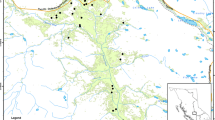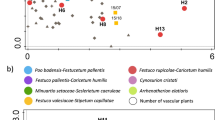Abstract
The effect of changing management practices, from a more intensive to a less intensive cutting regime with partial abandonment, on plant species composition, frequency, and abundance was determined for an oligotrophic wet grassland in the south Bohemia region of the Czech Republic using data from vegetation surveys conducted in 1965 (2–3 cuts per year) and 2013 (parts cut once per year, other portions abandoned). These data, coupled with nutrient data from a nearby wet grassland with similar species composition as well as data from the literature, were used to predict the possible effect of these vegetation changes on ecosystem processes and services. The former, more diverse Molinia caerulea-dominated state has been replaced by a less-diverse grassland dominated by clonal hemicryptophytes, such as Carex acuta. Partial restoration has been accomplished where mowing has been resumed. Using Ellenberg indicator values for moisture and nutrients, the present species composition indicates that the area has become wetter over time, likely due to management decisions made at the regional scale. Carbon and nutrient sequestration has likely been enhanced in the current state, while services linked to greater species diversity have likely suffered. Such tradeoffs in ecosystem services must be considered when deciding whether to restore the more diverse Molinia caerulea-dominated state. Decisions at the regional scale will also influence the ability of achieving a desired structure.




Similar content being viewed by others
References
Aerts R (1993) Nutrient turnover in Dutch heathlands during succession from ericaceous to gramineous dominance. Scr Geobot 21:7–15
Berg M, Joyce C, Burnside N (2012) Differential responses of abandoned wet grassland plant communities to reinstated cutting management. Hydrobiologia 692:83–97
Blažková D (1973) Pflanzensoziologische Studie über die Wiesen der Südböhmischen Becken. Studie ČSAV, 1973/10: 1–170, Praha.
Bobbink R, Hornung M, Roelofs JGM (1998) The effects of air-borne nitrogen pollutants on species diversity in natural and semi-natural European vegetation. J Ecol 86:717–738
Bollens U, Güsewell S, Klötzli F (2001) Vegetation changes in two Swiss fens affected by eutrophication and desiccation. Bot Helv 111:121–137
Bölöni J, Botta-Dukát Z, Illyés E, Molnár Z (2011) Hungarian landscape types: classification of landscapes based on the relative cover of (semi-) natural habitats. Appl Veg Sci 14:537–546
Boucníková E, Kucera T (2006) How natural and cultural aspects influence land cover change in the Czech Republic? Ekológia (Bratislava) 24(Supplement 2005/1):69–82
Brinson MM, Malvarez AI (2002) Temperate freshwater wetlands: types, status, and threats. Environ Conserv 29:115–133
Chytrý M, Tichý L, Dřevojan P, Sádlo J, Zelený D (2018) Ellenberg-type indicator values for the Czech flora. Preslia 90:83–103
Čop J, Vidrih M, Hacin J (2009) Influence of cutting regime and fertilizer application on the botanical composition, yield and nutritive value of herbage of wet grasslands in Central Europe. Grass Forage Sci 64:454–465
Daw TM, Coulthard S, Cheung WWL, Brown K, Abunge C, Galafassi D, Peterson GD, McClanahan TR, Omukoto JO, Munyi L (2015) Evaluating taboo trade-offs in ecosystem services and human well-being. Proc Nat Acad Sci 112:6949–6954
De Deyn GB (2017) Plant life history and above-belowground interactions: missing links. Oikos 126:497–507
Deng X, Li Z, Gibson J (2016) A review on trade-off analysis of ecosystem services for sustainable land-use management. J Geogr Sci 26:953–968
Duarte GT, Santos PM, Cornelissen TG, Ribeiro MC, Paglia AP (2018) The effects of landscape patterns on ecosystem services: meta-analyses of landscape services. Landsc Ecol 33:1247–1257
Edwards KR (2015) Effect of nutrient additions and site hydrology on belowground production and root nutrient contents in two wet grasslands. Ecol Eng 84:325–335
Edwards KR, Picek T, Čížková H, Máchalová-Zemanová K, Stará A (2015) Nutrient addition effects on carbon fluxes in wet grasslands with either organic or mineral soil. Wetlands 35:55–68
EEA (European Environment Agency) (2012) Protected areas in Europe—an overview. EEA Report No 05/2012, Copenhagen.
Feranec J, Soukup T, Taff GN, Stych P, Bičík I (2016) Overview of changes of land use and land cover in Eastern Europe. In: Gutman G, Radeloff V (eds) Land-Cover and Land-Use Changes in Eastern Europe after the Collapse of the Soviet Union in 1991. Springer, Switzerland, pp 13–33
Fontana V, Radtke A, Walde J, Tasser E, Wilhalm T, Zerbe S, Tappeiner U (2014) What plant traits tell us: Consequences of land-use change of a traditional agro-forest system on biodiversity and ecosystem service provision. Agric Ecosyst Environ 186:44–53
Franzaring J, Holz I, Fangmeier A (2008) Different responses of Molinia caerulea plants from three origins to CO2 enrichment and nutrient supply. Acta Oecol 33:176–187
Gaertner M, Konold W, Richardson DM (2010) Successional changes on a former tank range in eastern Germany: Does increase of the native grass species Molinia caerulea cause decline of less competitive Drosera species? J Nat Conserv 18:63–74
Galatowitsch SM, Whited DC, Lehtinen R, Husveth J, Schik K (2000) The vegetation of wet meadows in relation to their land-use. Environ Monit Assess 60:121–144
Hájek J, Poláková S (2010) The impact of cutting, liming and fertilizing on characteristics of abandoned upland meadows in the Czech Republic. Grass For Sci 65:410–420
Hájková P, Hájek M, Kintrová K (2009) How can we effectively restore species richness and natural composition of a Molinia-invaded fen? J Appl Ecol 46:417–425
Havlová M (2006) Syntaxonomical revision of the Molinion meadows in the Czech Republic. Preslia 78:87–101
Hejcman M, Češková M, Pavlů V (2010) Control of Molinia caerulea by cutting management on sub-alpine grassland. Flora 205:577–582
Hroudová Z, Hejný S, Zákravský P (1988) Littoral vegetation of the Rožmberk fishpond. In: Hroudová Z (ed) Littoral vegetation of the Rožmberk fishpond and its mineral nutrient economy. Academia, Prague, Czechoslovakia, pp 23–60
Joyce CB (2014) Ecological consequences and restoration potential of abandoned wet grasslands. Ecol Eng 66:91–102
Joyce CB, Wade PM (1998) European wet grasslands: biodiversity, management and restoration. Wiley, Chicester
Kącki Z, Michalska-Hejduk D (2010) Assessment of biodiversity in Molinia meadows in Kampinoski National Park based on biocenotic indicators. Polish J Environ Stud 19:351–362
Kaštovská E, Edwards K, Picek T, Šantrůčková H (2015) A larger investment into exudation by competitive versus conservative plants is connected to more coupled plant–microbe N cycling. Biogeochem 122:47–59
Kent P (2012) Vegetation description and data analysis: a practical approach. Wiley, Chichester
Klimeš L, Klimešová J (2002) The effects of mowing and fertilization on carbohydrate reserves and regrowth of grasses: do they promote plant coexistence in species-rich meadows? Evol Ecol 15:363–382
Kubat K (ed) (2002) Key to the flora of the Czech Republic. Academia, Prague
Kulik M (2014) Changes of biodiversity and species composition of Molinia meadow depending on use method. Pol J Environ Stud 23:773–782
Legendre P, Legendre L (2012) Numerical ecology, 3rd edn. Elsevier, Amsterdam
Ludwig JA, Reynolds JF (1988) Statistical ecology. Wiley, New York
Mälson K, Backeus I, Rydin H (2008) Long-term effects of drainage and initial effects of hydrological restoration on rich fen vegetation. Appl Veg Sci 11:99–106
McCune and Mefford, 2011 McCune B, Mefford MJ (2011) PC-ORD. Multivariate Analysis of Ecological Data. v. 6.08 MjM Software, Gleneden Beach, Oregon, U.S.A.
McInnes RJ, Everard M (2017) Rapid assessment of wetland ecosystem services (RAWES): an example from Colombo, Sri Lanka. Ecosyst Serv 25:89–105
Milligan AL, Putwain PD, Cox ES, Ghorbani J, Le Duc MG, Marrs RH (2004) Developing an integrated land management strategy for the restoration of moorland vegetation on Molinia caerulea-dominated vegetation for conservation purposes in upland Britain. Biol Conserv 119:371–385
Picek T, Lusby H, Čížková H, Šantrůčková H, Šimek M, Květ J, Pechar L (2000) Microbial activities in soils of a healthy and a declining reed stand. Hydrobiologia 418:45–55
Picek T, Kastovska E, Edwards K, Zemanova K, Dusek J (2008) Short term effects of experimental eutrophication on carbon and nitrogen cycling in two types of wet grassland. Community Ecol 9:81–90
Power AG (2010) Ecosystem services and agriculture: tradeoffs and synergies. Phil. Trans Royal Soc B 365:2959–2971
Prach K (2002) Human impact on vegetation around Rožmberk pond. In: Květ J, Jeník J, Soukupová L (eds) Freshwater wetlands and their sustainable future. Parthenon Publishing, Boca Raton, pp 187–194
Prach K (2008) Vegetation changes in a wet meadow complex during the past half-century. Folia Geobot 43:119–130
Prach K, Straškrabová J (1996) Meadows in the Lužnice River floodplain in the Třeboň Biosphere Reserve—potential for restoration. Příroda Praha 4:163–168
Quin SLO, Artz RRE, Coupar AM, Littlewood NA, Woodin SJ (2014) Restoration of upland heath from a graminoid- to a Calluna vulgaris-dominated community provides a carbon benefit. Agric Ecosyst Environ 185:133–143
Rodriguez-Echeverry J, Echeverria C, Oyarzun C, Morales L (2018) Impacts of land-use change on biodiversity and ecosystem services in the Chilean temperate forests. Landsc Ecol 33:439–453
Russi D, ten Brink P, Farmer A, Badura T, Coates D, Forster J, Kumar R, Davidson N (2013) The economics of ecosystems and biodiversity for water and wetlands. Switzerland, IEEP, London and Brussels, Ramsar Secretariat, Gland, p 84
Ružička M (1994) Ecological potential of floodplain area of the River Morava. Ekologia (Bratislava) 13:1–216
Sanon S, Hein T, Douven W, Winkler P (2012) Quantifying ecosystem service trade-offs: the case of an urban floodplain in Vienna, Austria. J Environ Manag 111:159–172
Šantrůčková H, Picek T, Šimek M, Bauer V, Kopecky J, Pechar L, Lukavská J, Čížková H (2001) Decomposition processes in soil of a healthy and a declining Phragmites australis stand. Aquat Bot 69:217–234
Šmilauer P, Lepš J (2014) Multivariate analysis of ecological data using Canoco 5. Cambridge University Press, Cambridge
Sterner RW, Elser JJ (2002) Ecological stoichiometry: the biology of elements from molecules to the biosphere. Princeton University Press, Princeton
Tallowin JRB, Jefferson RG (1999) Hay production from lowland semi-natural grasslands: a review of implications for ruminant livestock systems. Grass Forage Sci 54:99–115
Taylor K, Rowland AP, Jones HE (2001) Molinia caerulea (L.) Moench. J Ecol 89:126–144
ter Braak CJF, Šmilauer P (2012) Canoco 5. Canoco reference manual and user’s guide: software for ordination. (version 5.0), Microcomputer Power, Ithaca
Thornton B, Lemaire G, Millard P, Duff EI (1999) Relationships between nitrogen and water concentration in shoot tissue of Molinia caerulea during shoot development. Ann Bot 83:631–636
van Heerwaarden LM, Toet S, van Logtestijn RSP, Aerts R (2005) Internal nitrogen dynamics in the graminoid Molinia caerulea under higher N supply and elevated CO2 concentrations. Plant Soil 277:255–264
van Vuuren MMI, Berendse F, de Visser W (1993) Species and site differences in the decomposition of litters and roots from wet heathlands. Canad J Bot 71:167–173
Veen P, Jefferson R, de Smidt J, van der Straaten J. (Eds.) (2009) Grasslands of Europe of High Nature Value KNNV Uitgeverij, Zeist (Netherlands).
Verhagen W, van Teeffelen AJA, Verburg PH (2018) Shifting spatial priorities for ecosystem services in Europe following land-use change. Ecol Indic 89:397–410
Zelnik I (2005) Meadows of the order Molinietalia caeruleae Koch 1926 in south-eastern Slovenia. Fitosociologia 42:3–32
Acknowledgements
This paper is dedicated to the memories of Dagmar Dykyjová and Stěpan Husak, both of whom did so much to further our knowledge and appreciation of wetlands. We thank Ville Närhi for his great help as well as members of the Třeboň Basin Biosphere Reserve. Nutrient analyses were conducted by Daniel Vaňek. The study was supported by Grants from the Grant Agency of the Czech Republic (GACR: 526/09/1545) and the Grant Agency of the University of South Bohemia (GAJU: 143/2010/P).
Author information
Authors and Affiliations
Corresponding author
Ethics declarations
Conflict of interest
The authors declare that they have no conflict of interest.
Additional information
Communicated by Marjan Jongen.
Publisher's Note
Springer Nature remains neutral with regard to jurisdictional claims in published maps and institutional affiliations.
Electronic supplementary material
Below is the link to the electronic supplementary material.
Rights and permissions
About this article
Cite this article
Edwards, K.R., Kučera, T. Management effects on plant species composition and ecosystem processes and services in a nutrient-poor wet grassland. Plant Ecol 220, 1009–1020 (2019). https://doi.org/10.1007/s11258-019-00970-9
Received:
Accepted:
Published:
Issue Date:
DOI: https://doi.org/10.1007/s11258-019-00970-9




